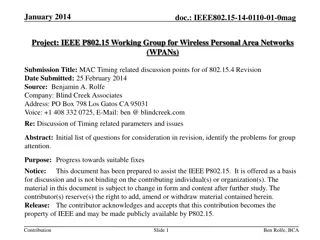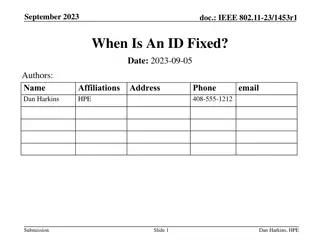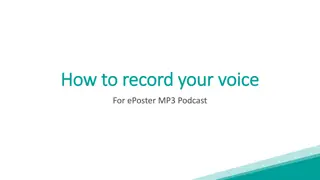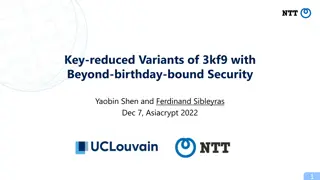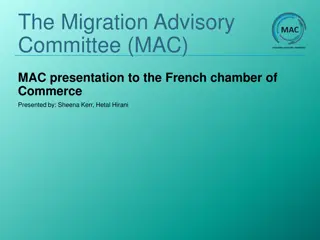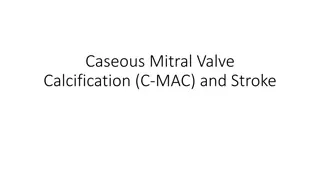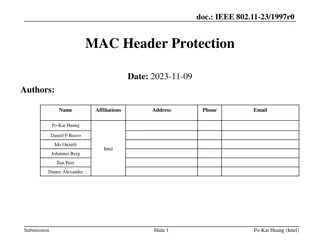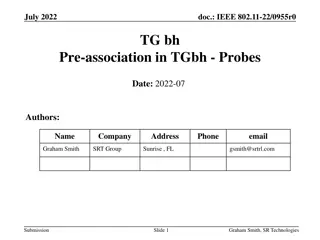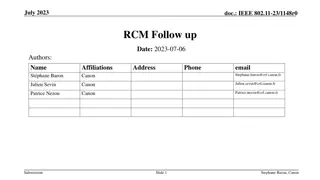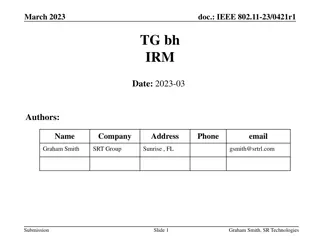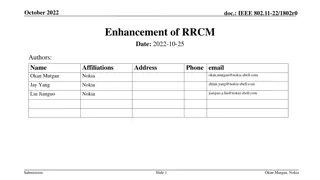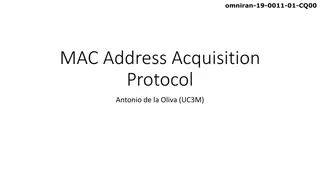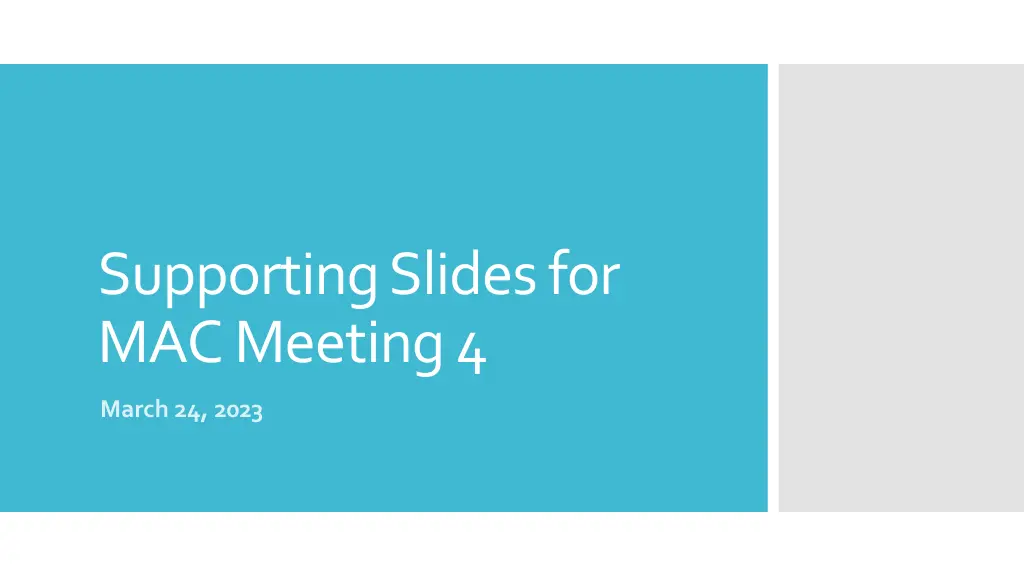
Regional Homelessness Prevention and Rehousing Initiative Update
Explore the progress and strategies of a regional initiative aiming to prevent homelessness, create new shelter beds, and rehouse unsheltered households through a multi-phased approach. Updates include the formation of a Multi-Agency Coordination Group, progress on prevention goals, and feedback from the state for further refinements to achieve the set objectives by 2024.
Download Presentation

Please find below an Image/Link to download the presentation.
The content on the website is provided AS IS for your information and personal use only. It may not be sold, licensed, or shared on other websites without obtaining consent from the author. If you encounter any issues during the download, it is possible that the publisher has removed the file from their server.
You are allowed to download the files provided on this website for personal or commercial use, subject to the condition that they are used lawfully. All files are the property of their respective owners.
The content on the website is provided AS IS for your information and personal use only. It may not be sold, licensed, or shared on other websites without obtaining consent from the author.
E N D
Presentation Transcript
Supporting Slides for MAC Meeting 4 March 24, 2023
Our region must spend $14-14.5 million (not obligate, spend), to achieve the following by January 9, 2024: Prevent 354 households from becoming homeless Creating 81-83 new shelter beds Rehousing 157-162 unsheltered households There are 5 phases of this initiative: Phase 1: State Funding, and Establish Multi-Agency Coordination Teams Review *Phase 2 (Current Phase): Regional Strategies, Community Priorities, and Draft a Regional Plan Phase 3: Determine Local Capacity, Identify Outstanding Support, Resource Needs, and Develop Local Implementation Plans Phase 4: Implement Plan, and Monitor Systems Improvement Phase 5: Document Lessons Learned, Determine Regional Impact for the needs of 2024
Created the Multi-Agency Coordination Group for the region. Created a high-level process for selecting regional strategies and project submission Meetings Discussions with partners Surveys Reviewed the Data - HMIS, Census, PIT Count, McKinney-Vento Youth Homelessness, System Performance Measures, etc. Submitted first draft of Regional Plan and Planning Worksheet on March 10th. The plan isn t finished What we ve covered so far
New prevention goal From 1,113 to 354 people Funding flows through Community Action Agencies Separate from the ~$14m, about $1.3m in additional funding As of right now, this funding can t be complemented by the ~$14m, $1.3m is all prevention gets CAA s are still encouraged to follow the MAC processes and priorities Some Updates and Clarifications Rehousing Goal is specific to unsheltered homelessness, meaning folks can t move from a shelter to housing. This goal will likely require intensive street outreach and case management. Once goals are met, there is some flexibility on how funds are used, if we have funding leftover. Initial focus is 100% towards goals, but for partners that fill other gaps in the homeless response system, we re hoping to create additional opportunities later this year if everything goes according to plan. COIC will be drawing on a portion of the administrative funding for our efforts throughout this process.
Conditional Approval is a good thing! Some communities plans were not approved. We still have a bit further to go and version 2 is due March 31st. State feedback (high level): Complete additional budget tabs in the All In Planning Workbook More thorough Goals & Milestones, specifically: Narrative specifying strategies that will be used to meet RRH and ES goals Amending timeline to include more explicit milestones, like when property will be acquired, units rehabbed, when funds will be allocated, subrecipient agreements signed, etc. Further clarify plan to increase shelter beds. State Feedback on Plan Towing the line between providing additional specificity on ideas, while caveating that it s subject to change upon Application Review Subcommittee s feedback and which projects are ultimately awarded funding.
Partners have provided some feedback: Our list of service providers for specific subpopulations missed a few orgs More emphasis on Crook & Jefferson Counties is needed Need to think critically about how to expand the MAC Community Feedback on Plan Some more information related to current services and investments is needed We ve received many (18) project proposals within the project concepts survey. Highly concentrated in Bend and Redmond How can we more effectively provide outreach and engagement to Crook & Jefferson Counties? How can the MAC (you all) help us get the word out?
18 Total Project Concepts between Shelter and Rehousing (7 Shelter and 11 Rehousing) $31,221,000 in total requests Common Themes: Subpopulation Specific Programs Pretty close b/n Capital Costs and Operating Funding Non-Congregate Shelter Street Outreach/Case Management Scalable Projects Project Concepts Submission Analysis Things that aren t as common, that we d like to see more of: Landlord Incentives Centering Lived Experience Quickly Implementable Programs Projects based outside of Bend, Redmond, and Sisters Common Barriers: Lack of leveraged/complimentary funds (IE acquisition request without a fully developed proposal of how operations would be funded) Project timelines/shovel readiness Tangentially related to State goals Lack of experience/established partnerships in providing the proposed program Common Questions we have about Project Concepts: How will operations be sustained after one-time funding expires? Who would operate the proposed project? Providers are operating at max capacity How many people/households would your project directly impact? Is shelter an allowable use on the property you re considering? Is there a limit to how many structures you could build or people you could house?
Setting up Grants/Project Review Subcommittee Creating Application Process Administering Funding & sub recipient agreements Ongoing Monitoring of Progress Towards Goals Next Steps
1. Timeline is achievable by deadline 2. Acquisition vs. Operating funding request 3. Funding Sustainability How will this project continue past this one-time funding? 4. Subpopulation specific - How will funding be used to impact subpopulations disproportionately more likely to experience unsheltered homelessness (BIPOC, LGBTQ Youth, Medically Vulnerable, Veterans) 5. Estimated Cost per client or unit 6. Which community will be impacted most by your project? 7. What is your organization s experience providing this type of service? 8. Leverage/Funding Match 9. What established partnerships do you have related to your program to ensure greatest impact? 10. Tell us specifically how your project will measurable (with specific numbers) impact the State-established goals. 11. How will you meet the Coordinated Entry and HMIS requirements? Funding Priorities Under Consideration (high level)
Website is up to date www.coic.org/EO2302/ Updated Prevention Target Draft Contract from the State Plans submitted on March 10th Meeting Materials for today Access to next Thursday s meeting Thank You!




